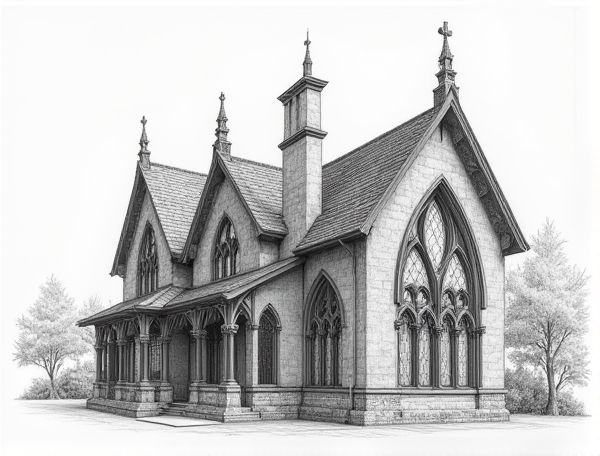
Photo illustration: Gothic revival home design with pointed arch stained glass windows
Gothic Revival home design features striking pointed arch stained glass windows that create a dramatic interplay of light and color, adding timeless elegance and intricate detail to your living space. Explore the full article to discover how these architectural elements can transform your home with historical charm and artistic flair.
Introduction to Gothic Revival Home Design
Gothic Revival home design emphasizes verticality, pointed arches, and intricate detailing inspired by medieval Gothic architecture. This style incorporates steeply pitched roofs, ornate tracery, and decorative elements like finials and lancet windows to evoke a dramatic and historic atmosphere. Your home's aesthetic can be transformed by integrating these distinctive features, creating an elegant and timeless environment.
Historical Origins of Gothic Revival Architecture
Gothic Revival architecture, emerging in the late 18th century and reaching its peak during the 19th century, draws inspiration from medieval Gothic designs characterized by pointed arches, ribbed vaults, and flying buttresses. You can incorporate these historical elements into your home design to evoke a timeless, dramatic aesthetic rooted in the romanticism of the medieval period.
Key Characteristics of Gothic Revival Homes
Gothic Revival homes feature pointed arches, steeply pitched roofs, and intricate wooden trim known as vergeboards, emphasizing verticality and ornate details. Large windows with decorative tracery and lancet shapes allow ample natural light, enhancing the dramatic, historic ambiance. Your home can embody medieval charm through these key characteristics, blending romantic aesthetics with functional design.
The Significance of Pointed Arch Stained Glass Windows
Pointed arch stained glass windows enhance home design by combining structural elegance with artistic expression, allowing natural light to filter through vibrant colors and intricate patterns. These windows not only add a timeless Gothic architectural element but also increase the aesthetic value and uniqueness of your living space. Incorporating pointed arch stained glass elevates your home's ambiance, creating a captivating focal point that reflects your personal style.
Materials and Techniques for Stained Glass Windows
Stained glass windows are crafted using techniques such as copper foil wrapping and lead came joining, utilizing materials like colored glass, silver stain, and vitreous paint for durability and vividness. Modern advancements include laminated safety glass and UV-resistant coatings, enhancing longevity and maintaining the vibrancy of intricate designs in home interiors.
Interior Design Elements in Gothic Revival Homes
Gothic Revival homes feature intricate interior design elements such as pointed arches, ribbed vaults, and ornate wooden paneling that create a dramatic and historic ambiance. Rich stained glass windows, decorative tracery, and dark mahogany furnishings enhance the architectural authenticity and evoke the medieval Gothic aesthetic.
Enhancing Curb Appeal with Pointed Arch Windows
Pointed arch windows elevate home design by blending Gothic elegance with modern aesthetics, significantly boosting curb appeal and architectural interest. Their unique silhouette allows natural light to flood interior spaces while creating a striking exterior focal point that increases property value.
Modern Interpretations of Gothic Revival Design
Modern interpretations of Gothic Revival design blend classic pointed arches, intricate tracery, and vaulted ceilings with sleek, minimalist materials like glass and steel to create a dramatic yet contemporary aesthetic. Your home can achieve a timeless elegance by incorporating gothic motifs into modern layouts, combining historical grandeur with functional, open spaces.
Maintenance Tips for Stained Glass Windows
Regularly clean stained glass windows using a soft cloth and mild, non-ammonia cleanser to prevent dirt buildup and preserve vibrant colors. Inspect the lead cames and solder joints annually for signs of corrosion or cracks to maintain structural integrity and prevent water damage. Applying a protective UV film can reduce fading and extend the lifespan of the stained glass artwork indoors.
Incorporating Gothic Revival Elements into Contemporary Homes
Incorporating Gothic Revival elements into contemporary homes enhances architectural character through pointed arches, intricate tracery, and ornamental stonework. Your design can seamlessly blend historical grandeur with modern functionality by integrating vaulted ceilings and stained glass windows into open-plan living spaces.
 homedesy.com
homedesy.com